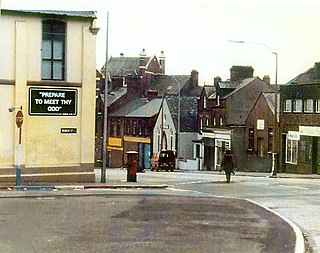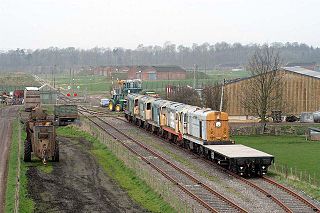
Kineton is a village and civil parish on the River Dene in south-east Warwickshire, England. The village is part of Stratford-on-Avon district, and in the 2001 census it had a population of 2,278, increasing to 2,337 at the 2011 Census.

Nesscliffe is a village in Shropshire, England, located north of the River Severn. The village comes under the Great Ness parish.
ROF Glascoed was initially a UK government-owned, Royal Ordnance Factory (ROF). It was designed as one of 20 munitions filling factories. It was planned as a permanent ROF with the intention that, unlike some other similar facilities, it would remain open for production after the end of World War II. After privatisation of the Royal Ordnance Factories in the 1980s it became part of Royal Ordnance plc and later a production unit of BAE Systems. It was served by the Great Western Railway's Coleford, Monmouth, Usk and Pontypool Railway from its opening in April 1940 until 1993.
Royal Ordnance Factories (ROFs) was the collective name of the UK government's munitions factories during and after the Second World War. Until privatisation, in 1987, they were the responsibility of the Ministry of Supply, and later the Ministry of Defence.

The Royal Army Ordnance Corps (RAOC) was a corps of the British Army. At its renaming as a Royal Corps in 1918 it was both a supply and repair corps. In the supply area it had responsibility for weapons, armoured vehicles and other military equipment, ammunition and clothing and certain minor functions such as laundry, mobile baths and photography. The RAOC was also responsible for a major element of the repair of Army equipment. In 1942 the latter function was transferred to the Royal Electrical and Mechanical Engineers (REME) and the vehicle storage and spares responsibilities of the Royal Army Service Corps were in turn passed over to the RAOC. The RAOC retained repair responsibilities for ammunition, clothing and certain ranges of general stores. In 1964 the McLeod Reorganisation of Army Logistics resulted in the RAOC absorbing petroleum, rations and accommodation stores functions from the Royal Army Service Corps as well as the Army Fire Service, barrack services, sponsorship of NAAFI (EFI) and the management of staff clerks from the same Corps. On 5 April 1993, the RAOC was one of the corps that amalgamated to form The Royal Logistic Corps (RLC).
An ammunition technician (AT) is a British Army soldier, formerly of the Royal Army Ordnance Corps but since 1993 of the Royal Logistic Corps, trained to inspect, repair, test, store, and modify all ammunition, guided missiles, and explosives used by the British Army. These technicians are also trained to use demolition to safely dispose of individual items of ammunition and explosives (EODs) or to conduct logistics disposal of bulk stocks of multi items. After gaining sufficient experience, those who show the appropriate qualities are given extra training to render safe improvised explosive devices (IEDs) by a process called improvised explosive device disposal. Experienced ATs may be called to give evidence as expert witnesses in criminal or coroner's courts in relation to ammunition or explosives or to EOD and IEDD duties.

An ammunition technical officer (ATO) is an officer involved in all aspects of the army, air force, and navy's use of ammunition. This includes: bomb disposal, clearance of ERW, explosives accident investigation, procurement, in service management, storage, and inspection and repair.

H.M. Factory, Gretna was the United Kingdom's largest cordite factory in World War I. The government-owned facility was adjacent to the Solway Firth, near Gretna, Dumfries and Galloway. It was built by the Ministry of Munitions in response to the Shell Crisis of 1915. The capital cost was £9,184,000 and it covered 9000 acres. The cost of working it from September 1916 to September 1918 was £12,769,000, during which time it produced cordite valued at £15,000,000, though it was claimed that without it the cordite would have had to be imported from the USA at a cost of £23,600,000.
11 Explosive Ordnance Disposal and Search Regiment RLC is a specialist regiment of the British Army's Royal Logistic Corps (RLC) responsible for counter terrorist Explosive Ordnance Disposal (EOD), the safe recovery or disposal of conventional munitions. The regiment also has an ammunition inspectorate role supporting the Inspector Explosives (Army). With headquarters in Didcot, the regiment has sub units geographically based throughout the UK to provide a nationwide high readiness response capability in support of the police.
The Defence Explosive Ordnance Disposal, Munitions and Search Training Regiment is an element of the Royal School of Military Engineering responsible for the delivery of training to British Army Ammunition Technicians, Ammunition Technical Officers and Search Operators. The Regiment delivers training from two locations: Marlborough Barracks, MoD Kineton near Kineton, Warwickshire and St George's Barracks, MoD Bicester, near Bicester, Oxfordshire.

Bramley Training Area is a British Army training camp, located south of the village of Bramley, Hampshire. Opened during World War I as an ammunition depot, the site now comprises a field training area and an Army Reserve Centre at Lapraik House, the base for C Squadron, 21 Special Air Service.

A Royal Naval Armament Depot (RNAD) is an armament depot dedicated to supplying the Royal Navy. They were sister depots of Royal Naval Cordite Factories, Royal Naval Torpedo and Royal Naval Mine Depots. The only current RNAD is RNAD Coulport, which is the UK Strategic Weapon Facility for the nuclear-armed Trident Missile System; with many others being retained as tri-service 'Defence Munitions' sites.

Defence Munitions (DM) Glen Douglas is a military munitions depot located near Loch Long, Argyll and Bute, in Scotland. It is operated by Defence Equipment & Support, part of the Ministry of Defence. It was formerly known as RNAD Glen Douglas.

The Central Ordnance Munitions Depot was constructed in the late 1930s by British for the World War II to combat the Japanese Invasion as well as to store arms and ammunition for the defence of Hong Kong. The British used "Little Hong Kong", name for the fishing village town of Aberdeen, as a "code name" to refer to the military site and therefore confuse Japanese spies in the local community before the Japanese invasion.

Norton Manor Camp, also known RM Norton Manor is a Royal Marines base located near Norton Fitzwarren, 2 miles (3.2 km) north west of Taunton, Somerset, in England. It is home to 40 Commando.

Pontrilas Army Training Area is a British Army training camp, located just north of the village of Ewyas Harold near to Pontrilas in Herefordshire, England. Originally developed pre-World War II by the Ministry of Defence (MoD) as an ammunition dump, it was served by the Golden Valley Railway.
Long Marston railway station was a station at Long Marston, Warwickshire on the Great Western Railway line between Stratford-upon-Avon and Honeybourne, which became part of the Great Western Railway's new main line between Birmingham and Cheltenham.
Defence Munitions Crombie is a military munitions depot on the upper Firth of Forth in West Fife, Scotland. The depot is located on the north shore of the river, south of the village of Crombie and west of Charlestown. The site commenced operations in 1916. It was formerly known as RNAD Crombie and DMC Crombie. It is now operated as part of the UK's Defence Storage and Distribution Agency.
Defence Munitions Gosport is a defence munitions site which is situated on the south western shores of Portsmouth harbour, southeast of Fareham in Hampshire. The site occupies about 470 acres. DM Gosport facilities include two Integrated Weapon Complexes (IWCs), 24 processing rooms and 26 explosives stores. The site employs some 270 staff.

British Army Germany, is the superior institution under which the remaining installations of the British Forces Germany are organised after the completion of the withdrawal of the British Forces from Germany in February 2020. Apart from the Alpine Training Centre Hubertus Haus in Oberstdorf, which is in Bavaria, British Army Germany is entirely based in North Rhine-Westphalia.














